The Korean Connection
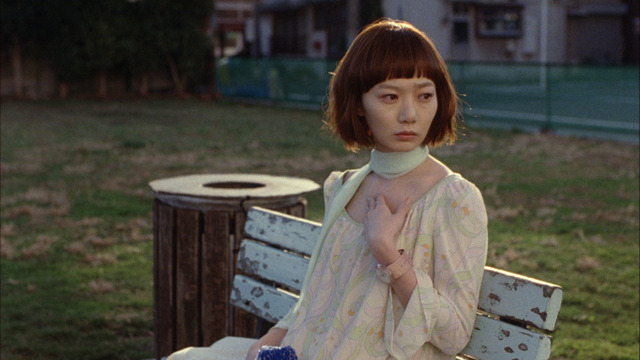

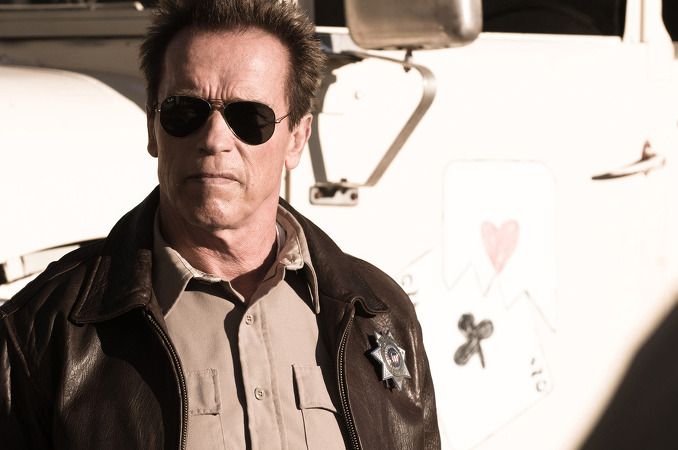
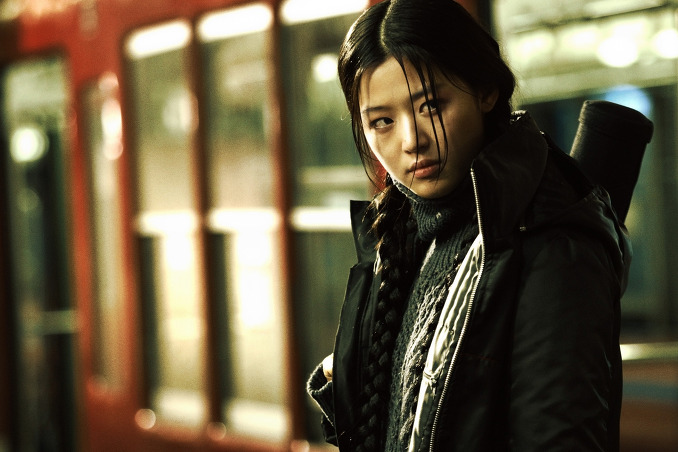
"Air Doll", "Stoker", "The Last Stand", "Blood: The Last Vampire"
As time passes, Korean cinema continues to become more and more international in its orientation. It's no longer seen as unusual for a Korean film to be set in a foreign country, or for a well-known international star like Isabelle Huppert to appear in a Korean film, as she did in Hong Sang-soo's In Another Country.
At the same time, Korean talent is becoming more active in the international film community. The talented Bae Doona can point to both Japanese films (Linda Linda Linda, Air Doll) and Hollywood films (Cloud Atlas) in her filmography. Korean directors like Park Chan-wook and Kim Jee-woon have both shot films in Hollywood. Technically, these works don't qualify as Korean films, but we realize that fans of Korean cinema will have a special interest in them.
Therefore we have created this page to provide reviews of films that are not quite Korean, but which nonetheless hold some significance for Korean cinema enthusiasts. This includes both productions that have been made with contributions from Korean talent, films by and about the Korean diaspora, and films which thematically hold some special interest for fans of Korean cinema.
Reviewed below: Koryo Saram (2007) Air Doll (2009) Our Homeland (2012) Comrade Kim Goes Flying (2012) Oldboy (2013) Stoker (2013) Seoul Searching (2015) Terminator Genisys (2015) Spa Night (2016) Columbus (2017) Gook (2017) Overseas (2019) Minari (2020) The Harbor Lights (2024).
When 16 year-old Saltanat Tuktubayeva from Kazakhstan came onto the Survival Audition K-Pop Star 3 reality show stage recently, she had come to the native land of her father. How her father's father, and tens of thousands of other ethnic Koreans, ended up in Kazakhstan is a long, arduous story, well-summarized in Y. David Chung and Matt Dibble's 60-minute documentary Koryo Saram.
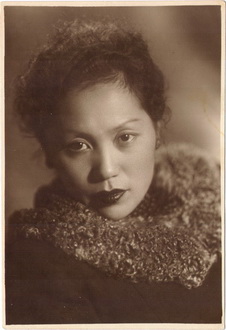 Using an old school word for the Kingdom peninsula and the Korean word for "person", "Koryo Saram" is the name ethnic Koreans throughout Russia and the former Soviet Republics use to refer to themselves. Those Koreans traveled to Russia across the 17 kilometer border initially due to famine, but later many more fled to escape Japanese imperialism. Even though many left to flee the Japanese and many fought against the Japanese later, Stalin saw them as 'unreliable people' who might support the Japanese during World War II and forcibly moved them from coastal regions like Vladivostok to what is now modern Kazakhstan and Uzbekistan in Central Asia. Because the USSR heavily controlled her people's movement, these ethnic Koreans did not have the freedom to return to either North or South Korea when the Korean War Armistice Agreement occurred. (A small delegate of Koryo Saram were sent to North Korea as advisers to Kim Il-sung, but he soon sent them back.)
Using an old school word for the Kingdom peninsula and the Korean word for "person", "Koryo Saram" is the name ethnic Koreans throughout Russia and the former Soviet Republics use to refer to themselves. Those Koreans traveled to Russia across the 17 kilometer border initially due to famine, but later many more fled to escape Japanese imperialism. Even though many left to flee the Japanese and many fought against the Japanese later, Stalin saw them as 'unreliable people' who might support the Japanese during World War II and forcibly moved them from coastal regions like Vladivostok to what is now modern Kazakhstan and Uzbekistan in Central Asia. Because the USSR heavily controlled her people's movement, these ethnic Koreans did not have the freedom to return to either North or South Korea when the Korean War Armistice Agreement occurred. (A small delegate of Koryo Saram were sent to North Korea as advisers to Kim Il-sung, but he soon sent them back.)
That is the shorthand version of how so many ethnic Koreans ended up in Kazakhstan. Chung and Dibble's documentary goes into greater detail through the well-placed use of photos, stock footage, and the heart-wrenching stories of the elder Koryo Sarams Chung meets on his journey through Kazakhstan. Chung narrates the film, mentioning how he was struck by the surreal multiculturalism of Almaty, Kazakhstan's largest city, a multiculturalism that seemed familiar to him, an American, yet different. He travels throughout the country learning from elders, scholars, and performances what life for the Koryo Saram was like in the past from the elders, and what it is like now for the youth.
The long tradition of trains and cinema provides many of the initial images. The Koryo Saram were put on trains to forcibly relocate them, trains Koryo Saram call 'ghost trains' due to the many who died on the journey. Since the dead could not be properly buried, ancient Korean tradition argues those souls remain restless about the countryside. This discussion is complemented with ghostly stock footage in a deteriorating state originally, or made to look that way for impact. Either way, it works. Equally powerful are some of the subtle gestures, such as the simple cutting of an apple for guests in one scene, apples having originated from what is now Kazakhstan. Kimchi is used as cultural mash-up metaphor in the film, since the cabbage to make it is grown in Kazakhstan from seeds from South Korea, but the spices are indigenous of Kazakhstan, a variation on the 'melting pot' model of multiculturalism that allows for differences to stand out more than, say, in a stew or soup.
Chung's narration points out many ironies of the suppression of Korean culture and language during Stalin's reign. By outlawing the direct teaching of the language, a rare dialect of Korean was maintained since the 'standard' Korean couldn't be written or read. But now with the opening up of Kazakhstan to the riches of South Korean import/export businesses and the dreamy draw of Korean pop stars, interest in the standard Korean language has rejuvenated. This freedom results in further ironies for Chung since the result is a reduction in the presence of the former dialect. Chung, a visual artist, underscores how much of the language and traditions have been maintained through the mediums of theatre and song, as well as rituals such as weddings and a boy's first birthday. In spite of the lingering traditions, the elderly Koryo Saram worry about the imperatives made by South Koreans in Kazakhstan, be it businesses demanding a particular commercial approach or South Korean Christians demonizing their shamanistic views. In addition, one Koryo Saram youth interviewed in the film mostly fraternized with Russians and Kazakhs until university, so those influences wield strongly as well. She is now majoring in Korean, hoping to travel there one day. As the elders fear, this is not so much the Korean of her Koryo Saram past, but the Korean of the present, that bright, shiny, and for some, prosperous Korean that brought Tuktubayeva to South Korea in hopes of K-Pop stardom. (Adam Hartzell)
Nothing may pique our cinephilia more than anticipating a film where a great director gets together with a great actress or actor. For those of us who follow contemporary East Asian cinema, Air Doll provides such a cinematic convergence.
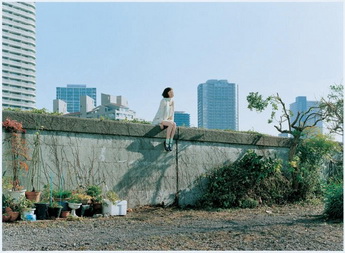 Air Doll finds itself on the 'The Korean Connection' page because it is at its core a Japanese film. The film takes place in Japan and the dialogue is in Japanese. It is produced by Japanese funders, is based on a Japanese manga, and is directed by a film festival favorite of Japanese descent, Kore-eda Hirokazu.
Air Doll finds itself on the 'The Korean Connection' page because it is at its core a Japanese film. The film takes place in Japan and the dialogue is in Japanese. It is produced by Japanese funders, is based on a Japanese manga, and is directed by a film festival favorite of Japanese descent, Kore-eda Hirokazu.
Kore-eda first impressed audiences with Maborosi, where we slowly watched a widow and widower tentatively approach an ambivalently arranged union. Loss and letting go continued to be a theme for Kore-eda in After Life, Distance, Still Walking, and I Wish. But Kore-eda reached his arguably masterful peak with the beautiful sadness of Nobody Knows, a film about siblings making due after being abandoned by their unstable mother. Although one must stretch to apply Kore-eda's themes of loss and letting go to Air Doll, this film continues an equally consistent theme of Kore-eda's, loneliness, while highlighting Kore-eda's skill at demonstrating the simple power of the observed and the unspoken.
As much as this film is dependent on the stewardship of a great director like Kore-eda, there is a great actress in this film as well, Bae Doo-na. The impact of this film is heavily dependent on her performance, and her presence is why this falls into 'The Korean Connection' page.
Although a greatly respected actress by many in the South Korean film industry and by those who come to this website, Bae's talent has not always resulted in huge home box office draws. Her presence wasn't able to save Tube, the failed Korean blockbuster that took Speed underground to the subway, while the success of Bong Joon-ho's The Host was not reliant on her performance. Because of this, Bae's star status is an enigma, something hard to place. The great description of Bae's standing in the larger cinematic constellation of world cinema can be found in Beck Una's wonderfully concise essay in the July-August 2009 issue of Korean Cinema Today. "By all account[s], she does not have the looks of a typical international star. The face which can make perspective powerless and is beyond intimacy. Her face is at the very unique spot where you can hardly argue whether it is pretty or not, or tell where she is from. Then we might call her an actress from earth, but even that seems far fetched at times.?" At the end of the piece, Beck resolves that "Perhaps it would be more apt to call her a universal actress."
As a universal actress in the age of hyper-globalization, Bae is free to venture anywhere. At first, Bae traveled across the watery and cultural divide that separates South Korea and Japan to extend the reach of her star status in the land of her country's former colonizer. There was her role as a zianichi (a Japanese resident of Korean dissent) in the Japanese TV series Someday and her role as a South Korean high school exchange student in the fun, fun, fun Linda, Linda, Linda. Along with the otherworldly visage noted by Beck, perfect for the uncanny nature of a doll coming to life, as an actress yet to be fully competent in the Japanese language, Bae's linguistic ability was perfect for Air Doll. Kore-eda has continually said how impressed he was with Bae's ability to demonstrate her character's growth into the language even within the sequential discontinuity required by the filming schedule. Likely due to both her performance in Air Doll and what Beck pegs as Bae's 'universal actress' aura, the Wachowski siblings and Tom Tykwer cast her to star in the other-worldly neo-Seoul section of Cloud Atlas (2012), along with having her appear as cross-racial characters in different time periods of the film.
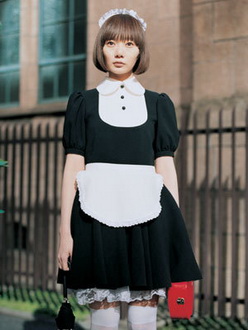 Ironically, Bae's role in Air Doll runs counter to what I and some other critics have appreciated about Bae, her willingness to go against the glamour imposed upon and pursued by many actresses (Korean or otherwise) and instead play roles where the characters are plain and not beautiful, at least not within the mainstream constructs of beauty. Watch her in Barking Dogs Never Bite and Linda, Linda, Linda and you don't see the doll that Bae becomes here. In Air Doll, Bae's beauty and Bae's body are on full display. Bae is an actress comfortable in her own skin, a good thing because she's in only her skin a lot in Air Doll. This constant nakedness of her indeed beautiful body might perpetuate the media-imposed feelings of inadequacy about one's body for some women as Lee Byung-heon's chiseled chest and washboard abs displayed prominently in The Good, The Bad, and The Weird made me feel about my unforgiving pathetic male body. Yet even though the beauty of Bae's angles and curves are part of the aesthetics of Air Doll, this is not the porn of mainstream movie undress. Bae brings a depth to this aspirated body's role that could have popped with failure had it not been for her and Kore-eda's talents.
Ironically, Bae's role in Air Doll runs counter to what I and some other critics have appreciated about Bae, her willingness to go against the glamour imposed upon and pursued by many actresses (Korean or otherwise) and instead play roles where the characters are plain and not beautiful, at least not within the mainstream constructs of beauty. Watch her in Barking Dogs Never Bite and Linda, Linda, Linda and you don't see the doll that Bae becomes here. In Air Doll, Bae's beauty and Bae's body are on full display. Bae is an actress comfortable in her own skin, a good thing because she's in only her skin a lot in Air Doll. This constant nakedness of her indeed beautiful body might perpetuate the media-imposed feelings of inadequacy about one's body for some women as Lee Byung-heon's chiseled chest and washboard abs displayed prominently in The Good, The Bad, and The Weird made me feel about my unforgiving pathetic male body. Yet even though the beauty of Bae's angles and curves are part of the aesthetics of Air Doll, this is not the porn of mainstream movie undress. Bae brings a depth to this aspirated body's role that could have popped with failure had it not been for her and Kore-eda's talents.
Air Doll begins by acknowledging the creepiness of the topic, where we follow home a man named Hideo where we are lead to believe he is greeting his wife Nozomi. We quickly discover his wife is in fact a blow-up doll. (There is a non-diegetic creepiness to this for Japanese audiences, since the actor playing Hideo is Itao Itsuji, a comedian who was unable to find work for a while due to his own sex scandals plastered across the tabloids.) The next morning Nozomi takes on life in the form of Bae's naked form. Nozumi's discovery of her embodiment is much of what propels the film, be it the remnants of melded plastic that outline her body, or how others perceive her 'body', such as a child's frightened response to Nozumi's surprisingly cold temperature. Nozomi's discovery of life and living works because of Bae's perfectly stammered walking of the line between childish innocence and an adult awareness of, if not mortality, her vulnerability in being a being of air-encased form. The vulnerability reveals itself in one of the most creatively erotic scenes in cinema, a verisimilitude of an orgasm as never seen on screen before. The juxtaposition of fear and joy that this scene heightens will be tonally flipped in a later scene, revealing the horror that peeks through occasionally in Kore-eda's work.
In fact, the horror here appears cyclically throughout Air Doll, from the beginning of Hideo's strange relationship with the blow-up doll, to the rape scene of a limp live Nozomi when her dual-life is exploited by her boss. (This latter scene reveals the reason behind what begins as a conceit, wondering how she could possibly get a job at a video store.) In many ways, Kore-eda and Goda Yoshiie, the creator of the manga upon which this film was partially based, are demonstrating the perversion and harm caused when disconnecting from others through objectification. Ironically, this is brought to light by bringing to life a non-human object rather than dehumanizing a human object. Yet equally disturbing is how Nozomi's innocence causes the horror of a later scene. Dressing someone up, metaphorically, if not literally, in french maid and baby doll costumes, can come back to haunt you indeed.
In the end, this is a film for all the lonely people. Another aspect of Bae's work that impressed Kore-eda is that Bae had to convey her character's sadness without the signifiers of tears, since her character's body would be unable to produce them. Bae's character connects with the sadness surrounding her, from the middle-aged woman who finds herself treated differently because she is no longer young, to the young hikikomori, the phenomenon of individuals in Japan who act as hermits in their own apartments, rarely leaving if only for food, piling up trash in their rooms to further wall themselves off from the outside world. (Bong Joon-ho explored this contemporary mental illness in Japan for his contribution to the omnibus film Tokyo!.) Yet this embrace of the lonely does not completely excuse their own responsibility in their condition. Hideo's rather didactic (in English) dialogue demands that Nozumi go back to mute doll-hood and Nozumi's comatose response to a rape in the film keeps the depictions of loneliness from being saccharine and innocent. It is a complicated loneliness brought about by individuals with particular options for agency within an ever atomizing world.
All of this is brought to life by one of South Korea's greatest contemporary actresses in a role within a film by one of Japan's greatest contemporary directors. Or better yet, Air Doll exemplifies what can be accomplished when two universal talents come together to make a universal film. (Adam Hartzell)
Yang Yong-hi's film Our Homeland, which I saw at the 2013 San Francisco International Film Festival, is a heart-wrenching tale of unresolved family tensions that are tightened up even further in zainichi Korean politics. For those unfamiliar with zainichi, let alone the politics, that is where we must begin.
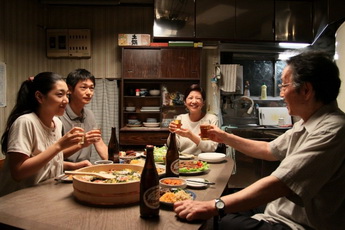 Zainichi is Japanese for 'residing in Japan' and it implies '(foreigner) residing in Japan'. Zainichi can be Taiwanese, Iranian, etc., but the zainichi we are talking about here are zainichi Korean. (For the rest of this review, I am going to follow the tradition of scholarly literature and just write "zainichi" instead of "zainichi Korean".) The reason there are a significant number of Koreans living in Japan is due to Japan's 35-year colonization of Korea from 1910-1945 when many Koreans were forced to migrate to Japan. During this time, many zainichi were connected with the Korean Independence Movement and when Japan surrendered, many returned to Korea. Still, a significant number stayed in Japan but maintained ties with their homeland. When their homeland split during the Korean War, the expectation arose for zainichi to state with which Korea they held their homeland allegiances. The majority stated their allegiances with North Korea. As a result, since zainichi are not considered full Japanese citizens unless they naturalize, their Japanese passports state this allegiance as well. Due to Japanese ideologies of pure blood nationality, zainichi have experienced discrimination in housing, employment, and social settings. Many first-generation zainichi continue to maintain ties to their chosen Chosun and while in Japan they maintain and advocate for a separate school system. But as David Chapman notes in his engaging overview of changing zainichi Korean identity, Zainichi Korean Identity and Ethnicity (Routledge, 2008), an alternate identity began to emerge for the second- and third-generations around the time of the Hitachi employment discrimination case (Hitachi shushoku subetsu saiban) which Pak Chong-sok won in 1974. In their view, Japan was their home and where they belonged. They would not deny their ethnic difference anymore than they would deny that they lived and belonged in Japan. This new zainichi identity, along with Burakumin (Japan's 'untouchables' caste), Ainu (indigenous peoples of Hokkaido), and other oppressed groups in Japan, contributed to developing a Japanese-specific multiculturalism. With different takes on identity across generations, some political tensions exist between younger and older zainichi. To quote David Chapman, "The social construction of zainichi identity is influenced by the zainichi population as well as the Japanese state" (p 143).
Zainichi is Japanese for 'residing in Japan' and it implies '(foreigner) residing in Japan'. Zainichi can be Taiwanese, Iranian, etc., but the zainichi we are talking about here are zainichi Korean. (For the rest of this review, I am going to follow the tradition of scholarly literature and just write "zainichi" instead of "zainichi Korean".) The reason there are a significant number of Koreans living in Japan is due to Japan's 35-year colonization of Korea from 1910-1945 when many Koreans were forced to migrate to Japan. During this time, many zainichi were connected with the Korean Independence Movement and when Japan surrendered, many returned to Korea. Still, a significant number stayed in Japan but maintained ties with their homeland. When their homeland split during the Korean War, the expectation arose for zainichi to state with which Korea they held their homeland allegiances. The majority stated their allegiances with North Korea. As a result, since zainichi are not considered full Japanese citizens unless they naturalize, their Japanese passports state this allegiance as well. Due to Japanese ideologies of pure blood nationality, zainichi have experienced discrimination in housing, employment, and social settings. Many first-generation zainichi continue to maintain ties to their chosen Chosun and while in Japan they maintain and advocate for a separate school system. But as David Chapman notes in his engaging overview of changing zainichi Korean identity, Zainichi Korean Identity and Ethnicity (Routledge, 2008), an alternate identity began to emerge for the second- and third-generations around the time of the Hitachi employment discrimination case (Hitachi shushoku subetsu saiban) which Pak Chong-sok won in 1974. In their view, Japan was their home and where they belonged. They would not deny their ethnic difference anymore than they would deny that they lived and belonged in Japan. This new zainichi identity, along with Burakumin (Japan's 'untouchables' caste), Ainu (indigenous peoples of Hokkaido), and other oppressed groups in Japan, contributed to developing a Japanese-specific multiculturalism. With different takes on identity across generations, some political tensions exist between younger and older zainichi. To quote David Chapman, "The social construction of zainichi identity is influenced by the zainichi population as well as the Japanese state" (p 143).
This is the political background that helps make sense of some of what happens in Our Homeland. As a zainichi herself, Yang Yong-hi has based this story partly on her own family's history. In Our Homeland, we learn that a repatriated son (Sung-ho, played by Arata, whom many will recall from Kore-eda Hirokazu's excellent film After Life.) is returning from North Korea for a brief 3-month stay to undergo treatment for a brain tumor. He was repatriated when he was 16 and hasn't been to Japan since. The family patriarch had to utilize his position in a zainichi North Korean organization to coordinate this 'unofficial' visit by his son. Of course, his son is followed by a North Korean comrade who keeps his eyes and ears on Sung-ho as much as possible, much to the consternation of the independent spirit that is Rie, the daughter of the family who was never repatriated to North Korea, but who is constrained in other ways by her community, such as her father's demands that she only marry a North Korean-affiliated zainichi. (Ando Sakura is a joy to watch in this spirited role of Rie, deservedly winning the 2012 Blue Ribbon Best Actress Award. Arata won Best Supporting Actor as well and the film went on to win Best Screenplay and Best Picture.)
The decision to initially repatriate the son was instigated by the father and is tied up in unspoken mystery. Much of the tension of the film is what lies beneath words, such as the bargaining chip the son had to offer up to the North Korean government to secure this temporary visit. Intrigue surrounds this family as what is left unsaid is finally said, or at least hinted upon. The regret of repatriation simmers throughout the film, building gradually to an anguishing crescendo and a final decision by Rie that underscores the re-calibration of zainichi identity by her generation.
As a second-generation zainichi born in Osaka, Yang demonstrates a respectful yet unflinching focus on the political tensions within the zainichi community. This is her first feature, and the discrimination faced by zainichi in Japan is less on display here, although when Rie arranges a basement bar reunion with Sung-ho's old school friends, one of whom is gay, discussion of being a 'minority within a minority' occurs and Sung-ho is credited with being one of the few folks who was kind to the outcast's outcast. Yang's other two films are documentaries about her family in North Korea, Dear Pyongyang (2005) and Sona, the Other Myself (2010). After making these two documentaries and stating forthrightly her criticisms of North Korea, Yang was eventually banned from North Korea. She still plans to make films about her family in spite of this trouble and in spite of her concerns for the safety of her family in North Korea. As Our Homeland underscores, it is the unsaid that can often lead us to decisions that we regret years later. It appears from Yang's documentaries and this first feature that she is dedicated to not regretting, for she refuses to stay silent in the face of discomforting politics, be they global or personal. (Adam Hartzell)
(Note: this review has been temporarily placed on this page only because we do not have a separate page for reviews of North Korean films. If such a page is ever launched in the future, we will move it then.)
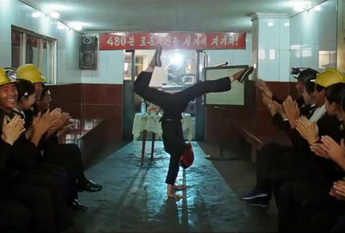 North Korean-Belgian-UK co-productions are a rarity in today's world. North Korea's state-controlled film industry does not often partner up with foreign partners to make films for local audiences or for export. But it does happen occasionally: examples include the North Korean-Japanese co-production Somi - The Taekwondo Woman (1997) and North Korean-Chinese co-production The Secret of Rikidozan (2005). Comrade Kim Goes Flying is a somewhat unique case. Nicholas Bonner, originally from the UK, has been living in Beijing since 1993, running Koryo Tours which organizes various kinds of cultural exchanges with North Korea. In recent years he has partnered with director Daniel Gordon to shoot a series of acclaimed documentaries in North Korea, including The Game of Their Lives (2002), A State of Mind (2004), and Crossing the Line (2006). These works have become well-known in North Korea, as well as internationally.
North Korean-Belgian-UK co-productions are a rarity in today's world. North Korea's state-controlled film industry does not often partner up with foreign partners to make films for local audiences or for export. But it does happen occasionally: examples include the North Korean-Japanese co-production Somi - The Taekwondo Woman (1997) and North Korean-Chinese co-production The Secret of Rikidozan (2005). Comrade Kim Goes Flying is a somewhat unique case. Nicholas Bonner, originally from the UK, has been living in Beijing since 1993, running Koryo Tours which organizes various kinds of cultural exchanges with North Korea. In recent years he has partnered with director Daniel Gordon to shoot a series of acclaimed documentaries in North Korea, including The Game of Their Lives (2002), A State of Mind (2004), and Crossing the Line (2006). These works have become well-known in North Korea, as well as internationally.
The idea for Comrade Kim Goes Flying was developed by Bonner and Belgian producer Anja Daelemans in 2006, and was originally conceived as a short film. After sharing the idea with North Korean producer Ryom Mi-hwa, with whom Bonner had collaborated on his documentaries, two North Korean screenwriters began working on a script. Although the story was originally rejected by the state-run film studios as "too unrealistic," Ryom was eventually able to get the film approved after numerous rewrites and after receiving the support of director Kim Gwang-hun, who is established as a director of "military films." Comrade Kim was shot with three directors, and two acrobats from the Pyongyang Circus in the lead roles. It then underwent postproduction in China and Belgium, giving it a glossy sheen that ordinary North Korean films lack.
The story centers around Kim Yong-mi, a young woman from the provinces who works in a coal mine, but who dreams of becoming a trapeze artist. When she is given a year-long assignment to work on a construction project in Pyongyang, she steals off to the Pyongyang Circus and manages to meet her childhood hero, the famous trapeze artist Ri Su-yon. Ri encourages her to audition for the Circus, but without any previous training, she humiliates herself. The arrogant trapeze star Pak Jang-phil mocks her, telling her that coal miners belong underground, not in the air. But Yong-mi is not one to give up easily.
Comrade Kim Goes Flying provides a memorable viewing experience. The 81-minute film contains an inside look at North Korea which certainly does not reflect the realistic, everyday experiences of its citizens, but which is fascinating nonetheless. Lead actress Han Jong-sim, who had no acting experience prior to taking this role, has an upbeat charisma that is infectious. As a film, it is genuinely entertaining. It is unlike most North Korean films in being centered around a single female protagonist whose dreams and ambitions are essentially personal. But in other respects, its North Korean screenwriters have given it a distinctly local feel.
Two difficult questions leap to mind while watching this film. The first is, is it "authentic?" In style it is not quite North Korean, and not quite Western. I couldn't help but ask myself if the film's kitschy charm was directed primarily at a North Korean or a Western audience. But it does seem to have struck a chord in North Korea after its general release in late 2012. While visiting the Udine Far East Film Festival in Italy, actress Han Jong-sim spoke of receiving fan mail from inspired viewers across the country. Also, the number of young girls auditioning for the Pyongyang Circus has reportedly shot up in the wake of the film's release. Given this, I think we should credit the film as being "authentically local."
The second question is, is it propaganda? In terms of its explicit content, the answer is no. At face value, it is a story of one woman's individual triumph. One might ask if the bright colors and the rosy view of North Korean life function as a kind of indirect, subliminal propaganda. (Though I think anyone asking this question should acknowledge that production companies and advertising agencies in the West are much more skilled at this sort of 'subliminal propaganda' than North Korean film studios ever will be.) Does Comrade Kim Goes Flying provide moral support to a dictatorial, highly oppressive regime? This may sound evasive, but I really do believe that viewers should watch this film and decide for themselves. (Darcy Paquet)
Before I go in, I am going to warn you that this review contains one or two spoilers about the original Oldboy. If you haven't watched the original and wants to remain in a pristine state of ignorance about one of the crazy-f*ck masterpieces of New Korean Cinema, then please don't proceed any further. Trust me, it's not worth getting spoiled out of this envious state of being, just so you can read about its vastly, massively inferior remake.
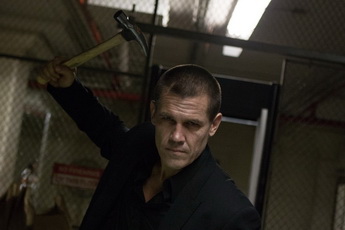 One of the hot Korean cinematic properties to be nabbed in late 2000s by Roy Lee and once attached to Justin Lin (The Fast and Furious films) and later Dreamworks with Steven Spielberg as the possible director, the Oldboy remake project then seemed to go out of steam and sputter to wheezing death as the new decade rolled in. However, to the surprise of many, the project was revived and offered to Spike Lee (Do The Right Thing), put in charge of a reasonably decent cast: Josh Brolin (Milk) as the American version of Oh Dae-soo, Sharlto Copley (District 9) in the Lee Woo-jin role and Elizabeth Olsen (Martha Marcy May Marlene) in the shoes of Gang Hye-jeong as Mido.
One of the hot Korean cinematic properties to be nabbed in late 2000s by Roy Lee and once attached to Justin Lin (The Fast and Furious films) and later Dreamworks with Steven Spielberg as the possible director, the Oldboy remake project then seemed to go out of steam and sputter to wheezing death as the new decade rolled in. However, to the surprise of many, the project was revived and offered to Spike Lee (Do The Right Thing), put in charge of a reasonably decent cast: Josh Brolin (Milk) as the American version of Oh Dae-soo, Sharlto Copley (District 9) in the Lee Woo-jin role and Elizabeth Olsen (Martha Marcy May Marlene) in the shoes of Gang Hye-jeong as Mido.
So how bad is it? Well, very bad. There is little doubt that this is one of the worst American remakes of Asian genre cinema I have seen: its underwhelming critical and box-office performance might actually help kill off the trend (and that would not be a bad thing at all). In fact, the new Oldboy not only is a lugubrious, pointlessly vicious clunker, almost entirely devoid of entertainment value and any artistic insight into the human condition, but also represents such a completely wrong-headed misconstrual of the original's unique qualities, that it becomes by default an almost perfect model example of what "Hollywood remakes don't get" about the Korean originals, not to mention the cinema of Park Chan-wook in particular.
Spike Lee, despite his reputation as a controversy-monger, had previously made more than a couple of good genre thrillers, notably Clockers (1995) and Inside Man (2006), so it wasn't exactly lack of talent that got him into this fiasco. To be fair, he was supposed to have disowned this theatrical-release cut, sheared of more than twenty minutes from his intended version, although to me the problem with the movie appears to lie deeper, in the way the project was conceived on the thematic level by Lee or his screenwriter Mark Protosevich (I Am Legend), than its structure or texture.
Lee's remake follows the original's plot closely with a minimum of creative adaptation. There is a bit more of the detail to the alcoholic misbehavior of Brolin's main protagonist, and an interesting take on the private jail as a kind of flea motel from Hell. On the other hand, Lee jacks up the violence quotient even higher than in the original. In Park's version, for instance, Oh Dae-soo tortures his jailer by performing amateur dental surgeries: here, Joe Doucette (Brolin) bloodily perforates the jailer's (Samuel L. Jackson, way too promiscuously choosing projects these days) neck with an X-Acto knife. The violence/action all quickly becomes impersonal, almost irritating, rather than flinch-inducingly dangerous or emotionally powerful: the original's notorious corridor-hammer single-take action sequence is pointlessly expanded to show more graphic bodily damage, but utterly lacking in wit, grace or excitement. The tone, comic-book bright and grandiloquently nutsoid in the original, is bleaker and more sullen, the entire film taking place in calculatedly dehumanized environments, be it the chrome-and-glass penthouse of Copley's villain or the arid, mock-chinoiserie flourish of the Chinatown streets (Lee also indulges in the borderline-ludicrous Dragon Lady fetishism but given many, many problems with this movie that is just a minor trifle).
Watching this remake, it is striking, too, how important the quasi-literary, bizarrely off-kilter ruminations by Choi Min-sik was to the original's sense of humor and twisted but intellectual cadences: Doucette in this movie is simply a massive hunk of muscle with little sense of irony or affectation, and it is hard to identify with him either as an anti-hero or as an everyman. Needless to say, his "romance" with the young case worker Marie (Olsen) is totally unconvincing, but neither actors can be faulted for being unable to do much with the critically underwritten roles they are saddled with.
But it is with the re-writing of the central relationship between Sharlto Copley's "villain" and Doucette as young men in Evergreen Academy that the film truly loses its bearings. It is difficult to talk about how this re-writing reshuffles and whitewashes character motivations of the original, without revealing some aspects of the original's final twist: suffice to say that the moral ambivalence and genuine sense of transgression attached to the original's incestuous relationships are totally wiped out in this remake: Copley's character is now simply a sick bastard, his relationship with his sister meaning less than zero: Doucette's "original sin" evaporates into nothingness in this reordered, American (sex-hating and male-centered) moral universe. All that remains is Lee's (or Protosevich's?) smirking derogation of the white class privilege, here equated with sexual perversity pure and simple. Instead of a thoughtless scoundrel who had driven a sensitive teenager to her death in the original, Oh/Doucette here is merely a callous rooster who happened to have inadvertently exposed the Biblical Abomination to the outside world. So there! Oldboy, vivisected, disemboweled and sewn together with new stuffing, is transformed into yet another A-Decent-White-Guy-against-the-Sicko-World movie, who gotta stick to Normal Sex on pain of losing his soul. Was this supposed to play well in Peoria?
When Robert L. Cagle and other film scholars inveigh against American critics, film producers and viewers for misunderstanding or dismissing without comprehending the moral philosophy behind Park Chan-wook's cinema and champion the latter's utter uniqueness, some might be tempted to retort, "Yeah well, there are Hollywood movies that do all that you claim Park's movies do." True enough. However, I must say that a case like the Oldboy remake does lend credence to Cagle and others' claims: Hollywood genuinely don't seem to get it. What make these Korean/Asian movies so uneasy, disturbing and yet haunting in the first place-- and these are not, by God, extreme violence, extreme misogyny, extreme sex and other Extreme Cinema claptrap-- are the first to be gutted and thrown away in the American remakes. The 2013 Oldboy illustrates this in an exemplary manner for all to see. (Kyu Hyun Kim)
Since late 2000s it has been more or less a foregone conclusion that one or more of the three Korean directors whose genre films have received much support not only among American film fans but also industry insiders- Park Chan-wook (Oldboy), Kim Ji-woon (A Tale of Two Sisters) and Bong Joon-ho (The Host)-- would take their projects to Hollywood, a la John Woo and Tsui Hark (Ang Lee's case is notably different). The only question was when and who first. As it turns out, Park and Kim almost simultaneously released their Hollywood-produced, English-language projects, a Hitchcockian thriller Stoker and an updated Western The Last Stand respectively, while Bong chose to mount a Korea-US-European co-production Snowpiercer based on a classic French SF comic, to open in time for the summer 2013 season.
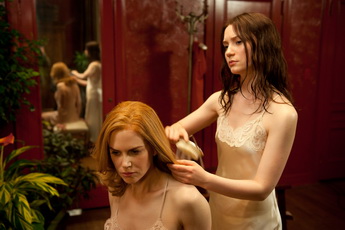 Stoker takes place in a regionally unspecific (Southern? No actor employs Southern accents, however) American small town. India Stoker (pouty Mia Wasikowska, looking like a cross between Bae Doo-na and Lee Young-ae) has just turned eighteen. Her father (wonderful Durmot Mulorney, regrettably not around much) just died in a suspicious car accident. Feeling morose, she barely gets along with her neurotic mother Evelyn (the more harried-looking-than-usual Nicole Kidman) who seems alternately jealous of and patronizing toward her. Her father's funeral brings an unexpected element of chaos to the household in the person of Uncle Charlie (overly creepy Matthew Goode). His sexual allure and dangerous mind-games drive a wedge between India and Evelyn, but as Charlie keeps upping the ante, India becomes aware that he is not merely an unconventional, free spirit but a homicidal psychotic.
Stoker takes place in a regionally unspecific (Southern? No actor employs Southern accents, however) American small town. India Stoker (pouty Mia Wasikowska, looking like a cross between Bae Doo-na and Lee Young-ae) has just turned eighteen. Her father (wonderful Durmot Mulorney, regrettably not around much) just died in a suspicious car accident. Feeling morose, she barely gets along with her neurotic mother Evelyn (the more harried-looking-than-usual Nicole Kidman) who seems alternately jealous of and patronizing toward her. Her father's funeral brings an unexpected element of chaos to the household in the person of Uncle Charlie (overly creepy Matthew Goode). His sexual allure and dangerous mind-games drive a wedge between India and Evelyn, but as Charlie keeps upping the ante, India becomes aware that he is not merely an unconventional, free spirit but a homicidal psychotic.
Stoker's basic setup is reminiscent of Hitchcock's Shadow of a Doubt (1943), but after the blueprint of family relationship has been laid out, the film moves along with its own agenda. First thing first: it will not disappoint Park's fans who had been afraid that Hollywood might have "defanged" him. Stoker fully retains most of the elements you expect from a Park Chan-wook brand: dazzling mis-en-scene and stylistic touches, this time zeroing in on the shiver-inducingly sensual textures of human hair, paper, shavings of a sharpened pencil and other familiar materials: face-slapping reversal of the audience expectations in the moral and emotional behavior of the characters, which a longtime fan of Park's oeuvre almost anticipates with glee (in this film, a particular scene involving a nude character and a hot shower, qualifies-- the American viewers I have seen this film with responded to it either with a disbelieving bark of a laughter or a stunned silence): vistas of breathless sexual entanglement and horrifying violence, discomfiting in their seductive beauty coexisting with conceptual perversity of the first order.
Adding subtle flavors to the already exquisitely picante dish are contributions from the top Hollywood talents now at Park's disposal, aside from his old collaborator, the veteran DP Chung Chung-hoon (The Unjust, New World): production design by Therese DePrez and others, costumes and styling by Kurt and Bart (who did Britney Spears's "pop diva" look) and, most notably for me, the sneakily witty score by Clint Mansell (Darren Aronofsky's longtime musical partner), with no less luminary than Philip Glass slipping in a piano piece for a memorable duet performed by India and Charlie.
Yet, Stoker in the end feels more like a reined-in try-out than a full-fledged piece-- the kind of song a brilliant singer would prepare to use at an audition, rather than an actual performance-- especially after the masterful reinterpretation of the vampire myth in Thirst (2009). I cannot help feeling that there is something missing. Perhaps the fault lies with Wentworth Miller's screenplay: even though everyone speaks with the perfectly "normal" English, the script is bereft of the sometimes bizarrely "literary," uniquely dense dialogues found in Park's other Korean films. Likewise, I found Stoker's generic American community lacking in the colorful cultural hybridity of Seoul and other Korean cities, an important factor in creating the organic whole that is a Park Chan-wook film. I believe the Korean critics's insistence at regarding Park's films taking place in an artificial, non-realistic environment often renders them blind to the specificity and materiality (even Koreanness) of Park's films.
This curious sense of detachment, if not anonymity, is amplified at the film's denouement, in which India actively embraces her identity as a product of her family history, replete with the unacknowledged sins and insanity: "my father taught me... that you sometimes have to do a terrible thing to prevent you from doing something worse," she intones. But ultimately, this was not convincing. India seems to have just walked down the preordained path, rather than having truly grown as a character (which the young Charlie does experience in Shadow of a Doubt, although it is probably unfair to keep comparing Stoker to it). Perhaps I was not the only Park Chan-wook fan who missed the crisp yet richly meaningful exchange that ended Thirst.
By no means a failure, Stoker is impressive and alluring, obviously a work of a brilliant artist. However, having experienced the emotional devastation as well as pulverizing stimulation of senses provided by Park Chan-wook's previous movies (including even JSA and I'm Cyborg But That's OK), I cannot help but feeling a tiny bit disappointed that it is a work easier to admire than to love. (Kyu Hyun Kim)
Director Benson Lee wrote his preliminary draft for what would become Seoul Searching just before the new millennium. This film about one summer in the short-lived tradition of annual South Korean summer camps for 'gyopo', (Koreans raised outside Korea), might have never been made were it not for the financial assistance of Chinese investors. Even when US distributors finally did take interest after the successful premiere screenings at Sundance, the offers weren't what director Lee feels the film was worth. As a result, Lee will be releasing the film on his own, working off local demand to determine release cities and dates. If you've been searching for a film such as this one, you will want to join their Facebook page and learn how to get this film to come near you, As for me, I thoroughly enjoyed watching this 80s remix at CAAMFest in the lovely Castro Theatre in San Francisco.
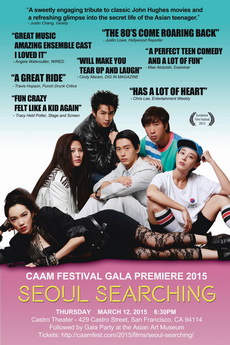 The year Seoul Searching takes place is 1986, when I was 16, the age of some of the characters on screen. The soundtrack is full of songs from my 80's. (OMD's "Forever Live and Die" accompanies the credits. Since the chorus is in my vocal range, I couldn't resist making this screening a sing-along at the end, the Castro Theatre my noraebang.) This makes me curious what percentage of the production costs went to securing music rights. But regardless how much, such costs did not result in Lee cutting any corners. This is a high quality production showing Lee is just as expert at crafting an engaging feature film as he was piecing together an enthralling narrative within his superb documentary Planet B-Boy (2007).
The year Seoul Searching takes place is 1986, when I was 16, the age of some of the characters on screen. The soundtrack is full of songs from my 80's. (OMD's "Forever Live and Die" accompanies the credits. Since the chorus is in my vocal range, I couldn't resist making this screening a sing-along at the end, the Castro Theatre my noraebang.) This makes me curious what percentage of the production costs went to securing music rights. But regardless how much, such costs did not result in Lee cutting any corners. This is a high quality production showing Lee is just as expert at crafting an engaging feature film as he was piecing together an enthralling narrative within his superb documentary Planet B-Boy (2007).
Lee does an excellent job of keeping a vast cast of characters going throughout the film. The diversity of gyopo experience in this film is part of what makes it so delightful. Lee was even able to cast, for the most part, actors who grew up in the same countries as their characters. There are American characters such as Sid the punk rocker played by Justin Chon (21 & Over & Revenge of the Green Dragons) and Grace Park the preacher's kid, Madonna-wannabe played by Jessica Van (upcoming TV series 'The Messengers' & 'Rush Hour'). Stepping away from the US, there is the German budding finance tycoon Klaus Kim played by Teo Yoo (German film Day Night Day Night and the Kim Ki-duk film One on One), the British Sara Han played by Sue Son ("Britain's Got Talent" 2007), and the Italian Marcello Ahn played by Yoon C. Joyce (Italian films The Mark & Se chiudi gli occhi). The only actor whose nationality is not in sync with his character is Mexican lothario Serge Kim, the debut role for Spaniard Esteban Ahn known across a segment of the Spanish-speaking internet for his "SanchoBeatz" YouTube series. In addition, he will soon be your new favorite actor because, as many have been saying, Ahn steals every scene he's in. His screen presence is truly infectious. The significant Korean actor cast is the teacher with a dark secret, Cha In-pyo (Crossing & The Flu). (Chon said his parents finally acknowledged him as an actor when they found out he would be working alongside Cha.) Although a small role, I was happy to see Crystal Kay playing the biracial character of Jamie since we too rarely see half-Black/half-Korean characters on screen, (former NFL star Hines Ward being the exception). Kay herself is African American and Korean. But she is also Japanese because she was born and raised in Japan, where she lives, records music in Japanese, and has been in a few Japanese movies (Giratina and the Sky Warrior & Yamagata Scream.)
There are clear references in Seoul Searching to the popular 80s oeuvre of John Hughes, right down to the promotional poster that is straight out of The Breakfast Club, just in time for the 30th anniversary of that Hughes' classic. As much as Hughes' films are said to define my generation, part of that definition was the racist caricature Hughes created in Long Duk Dong for Sixteen Candles (1984). Ask any Asian American man who grew up in the 80s, . . . actually, on second thought, don't ask them. They are tired of being reminded of the taunts of quotes from that movie. As Giant Robot magazine co-founder Martin Wong said to National Public Radio in the U.S., "Every single Asian dude who went to high school or junior high during the era of John Hughes movies was called 'Donger.'" Interestingly, Kirk Honeycutt recently revealed in Vanity Fair how Molly Ringwald, Ally Sheedy, and co-producer Michelle Manning took issue with a sexist scene in The Breakfast Club (1986) involving a synchronized swimming team. This scene was eventually cut. (Producer Ned Tanen axed a Russian janitor caricature played by Rick Moranis as well.). Sadly, no one on the earlier set of Sixteen Candles intervened to remove the Long Duk Dong character. So when CAAMFest Director Misashi Niwano called Seoul Searching a 'revision' of Asian America in the 80s, 'The Donger' character was clearly one of those 80s characters Seoul Searching discredits by showing actual Korean Americans (and Germans, Italians, etc) on an 80s screen. Seoul Searching revisits the 80s to remind us that Asian Americans existed, speaking in regional English accents, not in the racist accentuations voiced through Hughes' direction. In this way, Seoul Searching's could be a corrective for the harms Hughes caused on the playgrounds of the 80s.
There are many aspects of Seoul Searching I want to talk about in detail. There are aspects I want to praise and critique. But the film has yet to be released and the aspects of the plot I want to discuss can be considered spoilers. Let me speak cryptically then about one of the most moving scenes. Its impact is made stronger when ignorant of the Korean language because Lee chooses to not subtitle the scene. (It involves a tremendous performance played by Kim Ki-duk regular Park Ji-a.) And then Lee follows that scene later with parallel scenes of characters switching languages with a parent, demonstrating the intimacy that can be conveyed by a multilinguals language choice.
I will have to wait until after Seoul Searching has a significant theater run to discuss more. Considering that Benson Lee has been waiting 30 years to have this conversation, I figure I can wait six months or so.
Bring this movie to your town. Go see it with friends. Then we'll talk more later. (Adam Hartzell)
Just like I only went to see both Cloud Atlas and Jupiter Ascending because Bae Doona was in them, and how I plan to see Pixels because Peter Dinklage is in it and Trainwreck because of LeBron James, I wanted Paramount Pictures to know that I was only going to see Alan Taylor's Terminator Genisys because Lee Byung-hun was in it. So I did what the kids do these days. I tweeted them to make sure they knew. Forget Schwarzenegger. All profit from my roughly 15 dollar ticket should go to Lee. It's the least I could do considering he and his wife, actress Lee Min-jung, recently had their first child and I understand diapers are getting expensive.
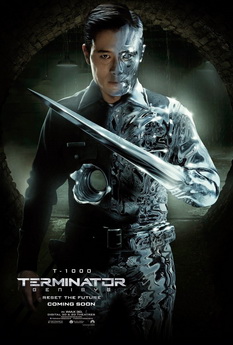 And the reason this American film shows up in this section of Koreanfilm.org is also because only because of Lee, which will explain why I will deal very little with the plot here where characters from the future go back in time and then a little forward to our time to make sure John Conner still survives. Or something like that. Schwarzenegger gets to battle his old self in this one, which I'm sure fans of the franchise appreciate. But I'm not a fan of the franchise so it's not really going to thrill me. I think I fell asleep during the first one. (Or was that Robocop?) And I never saw the other two between this and that one. The Terminator franchise could terminate for all I care.
And the reason this American film shows up in this section of Koreanfilm.org is also because only because of Lee, which will explain why I will deal very little with the plot here where characters from the future go back in time and then a little forward to our time to make sure John Conner still survives. Or something like that. Schwarzenegger gets to battle his old self in this one, which I'm sure fans of the franchise appreciate. But I'm not a fan of the franchise so it's not really going to thrill me. I think I fell asleep during the first one. (Or was that Robocop?) And I never saw the other two between this and that one. The Terminator franchise could terminate for all I care.
Yet I do care about Lee's role here and his stoic, spartan performance is pretty awesome. Wikipedia says he's a T-1000 shape-shifting liquid metal Terminator if that means something to you. He takes on the human form of an LA cop. He has only one line. I guess Terminators aren't really supposed to talk when we know they are Terminators. As a result, Lee is all silent bad boy cool, wreaking mayhem early on in the film. He has moments where he wields silver knife like arms and those are visuals that stay with me as much as his early days of bungee jumping. Lee plays the type of bad guy you root for over the so-called good guys. I really wanted his scenes to continue throughout the film, but other shape shifters needed bodies to fill.
San Francisco has been getting destroyed in a lot of films these days. It's stomped and collapsed in recent installments of the Godzilla and Planet of the Apes franchises and even the California Academy of Science gets blown up in the mash-up of San Francisco and Tokyo that is Disney's Big Hero 6. Why people love to destroy my city, I don't know. It's almost like they want another earthquake to happen, a la San Andreas. But there has been an even more disturbing aspect of destroying San Francisco we find yet again in Terminator Genisys. That is the destruction through almost complete invisibility of the city's majority of citizens - Asian Americans.
Part of the plot of Dawn of the Planet of the Apes involves a virus that has devastated the human population of San Francisco. This virus apparently disproportionately impacts Asian Americans based on how few are in the film, even when scanning the extras. In the San Francisco of 2017 presented in Terminator Genisys, there is only one Asian American, and as a co-worker pointed out to me, (plot spoiler), she technically isn't real. But what about Lee, you ask? His character roams the streets of Los Angeles, not San Francisco. Interestingly, one blockbuster that does represent the Asian American majority of my fair city via three major characters is the animated one, Big Hero 6. Where these blockbusters fail, indie flicks prevail. The films of Dave Boyle, specifically Surrogate Valentine, Daylight Savings, and Man From Reno, do a much better job of representing San Francisco's diversity. (Full diclosure - I play an extra in Man From Reno and have a wide spectrum of relationships on the friendship-acquaintance scale with folks who have worked on Boyle's films.) I couldn't agree more with this statement from Boyle on a recent episode of the Way Too Indie podcast. "It seems like ... most of the San Francisco movies ... take advantage of the atmosphere and the kind of European vibe that the city has, but they don't actually delve into what life is actually like for people living in San Francisco."
In the case of Terminator Genisys they do make an effort to cast African Americans in non-stereotypical roles. It even appears as if they may have read Martin Kevorkian's book Color Monitors: The Black Face of Technology in America (Columbia University Press, 2008) that I discussed in my D-War review. Terminator 2: Judgment Day provides solid support for Kevorkian's thesis of black operators of technology positioned to protect white bodies from the contamination of technology. Here in Terminator Genisys the trope is reversed. The president of the technology company Genisys and his assistant (vice-president?) have a white guy touch the technology for them in a clear depiction of technological contamination.
And through this jettisoning of a prominent racial trope in science fiction, Terminator Genisys ironically shows that productions can make the effort to address problematic aspects of narratives in cinema. Any excuses that a fictional San Francisco cannot represent the factual majority Asian American population is that, just an excuse. Actually, it's more than that, it's a lazy excuse. If they were as half-ass in their CGI depiction of the Golden Gate Bridge, there would be an uproar on social media. Further irony on this film's erasure of San Francisco's Asian Americans - (where are the Latinos too, by the way?) - is that it prominently features Lee Byung-hun. Plus Schwarzenegger was a two-term governor of California. You would think he'd know about the demographics of the fourth largest city in the state he served for eight years and he'd express concern about the city's representation. Now if we can only make it so that irony is not lost on Hollywood. If I were a Terminator, I'd go back to disrupt these white-washing casting decisions. Sarah Conner can clearly take care of herself anyway. (Adam Hartzell)
At this moment in gay history in the US, much emphasis is made on 'coming out', enunciating one's queerness verbally to family, friends and co-workers. C. Winter Han suggests caution with this gay orthodoxy. In his book Geisha of a Different Kind: Race and Sexuality in Gaysian America (New York University Press, 2015), Han notes,
 Because [Asian American] families often offer a source of social support that helps buffer the racism they encounter on a daily basis, simply coming out of the closet and joining the gay mainstream may not be an option that gay Asian American men view as being attractive if it means having to give up ties to their ethnic communities (p 182).
Because [Asian American] families often offer a source of social support that helps buffer the racism they encounter on a daily basis, simply coming out of the closet and joining the gay mainstream may not be an option that gay Asian American men view as being attractive if it means having to give up ties to their ethnic communities (p 182).
The problem with expectations of coming out imposed on queer people of color is that if coming out disrupts the cohesion of one's minority community, it is not as if the wider gay community will be fully accepting. The wider white gay community is just as prone to racism as the wider white non-gay community. Sample some of the profiles on the virtual cruising app Grindr and you will see 'No Asians' racism displayed as casually as 'No Mexicans' racism at a Trump Rally. The possibility of ostracism from one's ethnic community after verbally 'coming out' means one risks being severed from the community that can offer refuge when experiencing racism. A white gay person might also face ostracism when coming out, but they can find a queer community that still privileges their whiteness. Also, one can signify one's queerness in other silent ways. And one's family can send similar subtle signals of support. (Check out Benjamin Law's autobiographical TV series The Family Law where this everyone-knows-without-saying-it is lovingly, and hilariously, demonstrated within the context of a supportive Chinese Australian family, particularly episode 5, "Everything's Coming Up Roses".) An intersectional approach to identity is important in understanding what full choices individuals truly have. Choices come with different consequences for different groups. Part of what is so refreshing about Andrew Ahn's debut film Spa Night is that it displays this intersectional awareness so often ignored in films catering to a mainstream audience, even a mainstream gay one. Spa Night is not a coming out story. Spa Night presents a fully-realized individual who is a work in progress. It considers the intersectional layers of reconciling multiple identities, being Gay and Korean and American and Christian. David, (played in a wonderfully subdued manner by Joe Seo), doesn't want to jettison one of those identities to privilege another.
David's six pack selfies in the mirror of his bathroom is another aspect of Spa Night that recent scholarship on Asian American gay identity can help us unpack in many ways. We might too easily toss this aside as evidence of narcism, but it is clearly a source of sincere pride for David. Of all the things David can't control about his life, he is able to control how his body looks. It isn't clear if David is sharing these images on websites like Grindr, but the taking of headless naked torso shots features prominently on gay dating sites. Nguyen Tan Hoang closes his book A View from the Bottom: Asian American Masculinity and Sexual Representation (Duke University Press, 2014) by interrogating headless torso images posted by gay Asian men, ". . .They constitute a tactic that simultaneously contests and reaffirms the dominance of whiteness and the marginalization of Asianness in gay male communities" (p 200). David is meeting the expectations of mainstream gay desire by displaying his chiseled abs, but his refusal to show his face hides his Asianness. When Korean American drag queen Kim Chi affirmatively performed "Femme, Fat, & Asian" on the reality TV show RuPaul's Drag Race, he was confronting the three aesthetics disparaged in the mainstream gay community. Nguyen's scholarship reveals that David's selfies are ripe with paradox. They can express narcissism and confidence, they can be constraining and liberating, all in the same shot. (And we could go on and on with Lacan about taking selfies in the mirror, couldn't we?).
Ahn has said in interviews and post-screening Q&As that the inspiration for this film was a gay friend of his mentioning to Ahn that he once got an awesome handjob at a Korean spa. This shocked Ahn because his frame of reference was Korean spas were spaces for families, not orgasms. Ahn utilizes the fog of steam rooms, the Ozu-esque POV of on the floor camera angles, to surreptitiously hint at what is happening in the spas when hetero gazes aren't looking. In solidarity of desire, David offers assistance for cruising customer consummation while still presenting a hesitancy to participate himself. Much of the power of Spa Night is the cautious pace. David doesn't rush in, he prepares before submerging into the hedonistic bath that surrounds him. He savors the visual, haptic pleasures, well before reaching out and engaging in the tactile pleasures so close, yet so far from his reach. More time is spent in this secret sexual economy, much of which happens behind the closed steam rooms doors, but this secret society rhymes with the earlier hidden proceedings that led to the closing of David's parents' restaurant that we weren't permitted to witness earlier.
Ahn refuses an easy resolution in Spa Night. He's not letting the audience off the hook by providing them with final frame fulfillment. We have to sit in the sauna's oppressive environment, find ourselves slightly suffocating as we struggle to inhale. We have to hold all of David's layers, layers applied like rivers of sweat on our skins. We have to carry David's burden with us as we leave the theater. Spa Night does what I want cinema to do - it lives and breathes beyond the screen. (Adam Hartzell)
"Yes, yes,
tell me about that,
what moves you!"
- Jin (John Cho, Shopping for Fangs, Star Trek Into Darkness)
Smoking and cinema go hand in glove. Cigarettes give characters something to do with their hands. The smoke adds an ethereal air to a scene, huffing and puffing enabling dramatic pauses. And what is easier for a meet cute than offering or requesting a cigarette.
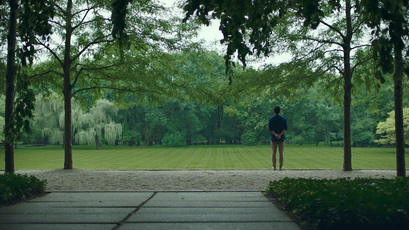 Jin and Casey (Haley Lu Richardson, The Edge of Seventeen, Split) do indeed meet via the exchange of cancer sticks. But the smoking in Kogonada's feature-length debut offers something more, including an adorable deconstruction of the meet cute cliché near the end. As our two main characters smoke around the many modernist monuments to the field of architecture that can be found in Columbus, Indiana, we also witness them drop their cigarettes and smush them out beneath their feet, embedding streaks of ash below. They don't even pick up these butts. They leave them there as if they don't care, leaving what they discard for someone else to clean up after them.
Jin and Casey (Haley Lu Richardson, The Edge of Seventeen, Split) do indeed meet via the exchange of cancer sticks. But the smoking in Kogonada's feature-length debut offers something more, including an adorable deconstruction of the meet cute cliché near the end. As our two main characters smoke around the many modernist monuments to the field of architecture that can be found in Columbus, Indiana, we also witness them drop their cigarettes and smush them out beneath their feet, embedding streaks of ash below. They don't even pick up these butts. They leave them there as if they don't care, leaving what they discard for someone else to clean up after them.
An argument can be made that they defame these structures through their trash and cinders. Yet part of the dialogue of Columbus delves into whether buildings can be sacred, the paradox of modernism and religion, so this littering among iconic buildings isn't inconsistent with the themes presented. But in not cleaning up after themselves, the scenes peppered throughout Columbus of cleaning ladies and groundskeepers take on greater meaning than as simply moments between what might be argued are the more 'important' scenes of dialogue. These interstitial scenes showing who cleans these modern buildings are ethical reminders that these buildings do not stand before us solely because of the genius of a solitary artist, but their awe-striking beauty is maintained because of the upkeep of folks whose labor is too often ignored. Kogonada offers moments to reflect on this important invisible labor and the people who perform it, such as Casey's mother (Michelle Forbes, TV shows such as The Killing & Battlestar Galactica). We are encouraged to be attentive to them because Kogonada respects them enough to be interested in their part in the process of great architecture and great art.
If you knew about director Kogonada's film work before Columbus, (which he edited and wrote the screenplay for as well), you've likely watched his mesmerizing video essays online discussing auteurs such as Japanese directors Ozu Yasujiro and Kore-eda Hirakazu. In fact, his video essay appreciating Ozu's hallways and alleys shines on in Columbus. There are transitional moments where we just stare at empty hallways and alleys, hallways that fully or partially become filled with a character, alleys that extras walk past in a distance. Like the people cleaning the buildings noted above, these intermittent interstitial spaces force us to be attentive, or better yet, implement the "critique of a critique" found by librarian Gabe (Rory Caulkin, You Can Count On Me, The Night Listener) in the marginalia of a book, to encourage us to be interested in the power of a hallway and an alley. The negative space of alleys define buildings as much as the hard walls. Hallways are entryways into characters' lives. Alleys are points of contemplation, a free negative space that helps define the hard positive space of a building's walls.
The city of Columbus, Indiana and the multiple Modernist artworks and architecture found within it are as much of a character in Columbus as the actors strolling, sitting, standing and smoking within and around them. Seven buildings in this little town are on the US National Registry of Landmarks and 60 more buildings result in Columbus' nickname as "Athens of the Prairies". When Casey says the Columbus City Hall designed by Edward Bassett sits on her list of favorites in the 'late teens, 20s', you realize she is ranking only the buildings in her city, not ranking all buildings everywhere. Esteemed architects such as father and son Eliel and Eero Saarinen, I.M. Pei, James Stewart Polshek, Robert Venturi, and Deborah Berke all have prominent buildings in this small town in middle America. The inclusion of Berke's First Financial Bank of Creekview as a very significant one for Casey is a lovely touch on Kogonada's part since architecture is a field heavily dominated by men. Despina Stratigakos wrote a whole book entitled Where Are the Women Architects?.
The power of negative space extends from the buildings alleys and hallways to the dialogue of the characters. Kogonada's dialogue is full of elliptical endings. Many lines dot, dot, dot off into the undeclared, the unacknowledged, the yet to be fully formed. There is the ambivalent romance developing between Jin and Casey, so well scripted and delivered in the scene amongst the glow of Berke's bank. (That line about Casey's mom is echoing in my head as I type.) There is the unspoken amongst the spoken that every bit of dialogue must balance well, and Kogonada has built such perfect balance here, the unspoken alleys between the spoken walls of the buildings that support his well-developed characters.
For those who do not know, although the director's nom de plume sounds Japanese, he is Korean American. But it would be a stretch to claim any South Korean films influencing Kogonada's work. The influences I find are Japanese. I've already mentioned Ozu, but the dialogue, the struggles with family, no director has the patent in such concerns, but I feel Kore-eda's strong embrace throughout Columbus. And I'm not sure who might have inspired that mirror play in a later scene, or if it's an original idea with no mentor antecedent, but sitting here thinking about that scene, I find myself experience sweet delight in how expertly Kogonada pulled it off.
Korea, if not its cinema, is present here. There's the father/son tension around cultural obligations and in the joke about K-drama. When white lady Eleanor (Parker Posey, Personal Velocity, The Oh in Ohio) drops casual spoken Korean, the global rise of Korean culture in the 21st century makes Eleanor's linguistic ability less dissonant than such a character may have felt a couple decades earlier.
Then there is the awkward conversation that begins Jin and Casey's meet cute, where Jin deflects surprise at his Korean American Americanness, an experience shared by so many Asian Americans. The fact that this is John Cho playing this character that he should have been playing many times over for many years makes this scene even more powerful. I was introduced to Cho as an actor in Shopping for Fangs, the 1997 co-directed sophomore feature from Quentin Lee and debut from future powerhouse Justin Lin. There is a scene in that film where Cho seductively licks an envelope. It is an incredibly sexy moment while also having a comedic edge. That moment should be an iconic image of 90's American cinema. But that scene isn't montaged amongst other 90's films because of the unbearable whiteness of Hollywood at that time obstructing the range of Shopping for Fangs release. That time is still now, but better inroads are being made. In her article on and interview with Cho for GQ, Nicole Chung sums Cho's presence in Columbus perfectly. "His lead performance . . . is so genuine it almost makes you forget it's John Cho as you might not have seen him before." Cho has not been provided the opportunities to be the genuine romantic lead so many of us have wanted him to be. In Columbus we have a film that provides so many lovely moments. Perhaps loveliest of all is that an actor so deserving of such a role is finally provided his close up that he's been ready for years to perform. (Adam Hartzell)
Korean Americans stand on top of roofs in Justin Chon's sophomore feature Gook, but they are not reinforcing the image from the 1992 Los Angeles Riots of armed Korean American men on the rooftops of Koreatown, "the most durable and dispiriting images of that era", as Los Angeles Times' reporter Jim Newton put it in an article on January 18, 2011. Yet Chon's rooftop Korean Americans bear no arms. In fact, they in some ways bear feet. They are not in Koreatown. They are in Paramount, where director Chon's family grew up. On these roofs the two young men are at moments scared, at moments defiant, almost playful. All of this seems to be an effort to recalibrate the iconic image of the 1992 LA Riots*. Their expression of masculinity on this rooftop is complicated, not a caricature. Going into greater detail would spoil a major reveal, but it is significant that the roofs are revisited and refashioned away from being a place to potentially respond to violence with violence. (And since this is a website primarily for films from South Korea, let me add that my particularly curated cinephilic neurons were churning up images of Ahn Sung-ki & Park Joong-hoon defiantly atop the billboard of Park Kwang-su's 1980's classic Chilsu and Mansu)
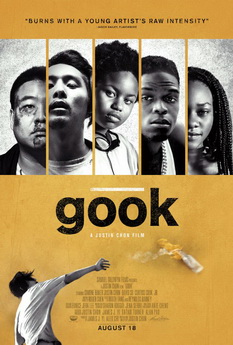 Chon's film further expands our understanding of the rooftop Korean Americans during the LA Riots by providing the context of the military readiness of the immigrant men in the iconic image. South Korea requires military service of all its citizens. A few rich folks are able to weasel their way out of the service, but the adult Koreans who immigrated to the US in the 70s and 80s were not wealthy. The Korean immigrant men in the US knew how to use a rifle from their training. The men on the Korean language radio stations had the same military experience and acted as support when they felt the police abandoned their community. The importance of Korean language radio stations acts as an opportunity for the character Mr. Kim to explain this context to the character Daniel, and the audience members unaware of this aspect of the riots.
Chon's film further expands our understanding of the rooftop Korean Americans during the LA Riots by providing the context of the military readiness of the immigrant men in the iconic image. South Korea requires military service of all its citizens. A few rich folks are able to weasel their way out of the service, but the adult Koreans who immigrated to the US in the 70s and 80s were not wealthy. The Korean immigrant men in the US knew how to use a rifle from their training. The men on the Korean language radio stations had the same military experience and acted as support when they felt the police abandoned their community. The importance of Korean language radio stations acts as an opportunity for the character Mr. Kim to explain this context to the character Daniel, and the audience members unaware of this aspect of the riots.
In tackling the 1992 LA Riots, or, as spoken of in the Korean tradition of the date, Sa-I-Gu, or '4-2-9', Chon knew he had a responsiblity to do his best to provide depth to all his characters. As a result of budget and running time limitations, Chon could only do so much. During a Q&A with TV/Film critic Inkoo Kang via remote video after a screening at the Roxie Theater in San Francisco, Chon said a wider role had been written for Jesus (Ben Munoz - A Father's Journey, Enemy Within) that presented him more as a father figure. This was an attempt to address how what the media presented as just a Black/Korean dyad was in reality a triad of Black/Korean/Latinx**. Others have underscored the problematic fact that the film includes no Korean American women. These are valid complaints that underscore where the film fails. But it also speaks to a need for more films on the topic. As Nancy Abelmann and John Lie demonstrate in Blue Dreams: Korean Americans and the Los Angeles Riots (Harvard University Press, 1997), there are many stories to tell about the varied relationships between African Americans, Korean Americans, and Latinx Americans during the riots. Abelmann and Lie's medium had more space to tell more stories, (as does Grace Lee's excellent (and much longer) interactive documentary K-TOWN '92).
Gook takes place in one day, the day the verdict came down acquitting all four LAPD cops of charges of excessive force in the beating of Rodney King. Chon's inspiration for this single day narrative, (and black and white cinematography), was Mathieu Kassovitz's La Haine a film that takes place in a single day of Paris' diverse suburbs. The full-circle-ness of Chon's homage to Kassovitz's black/blanc/beur trio inspiring Chon's Black/Korean/Latinx triplet is one of those intriguing aspects of globalization's Escherian nature. As Felicia McCarren notes in her book French Moves: The Cultural Politics of le hip hop (Oxford University Press, 2013), "La Haine broke through to a global audience but also signaled a breakthrough in showing the effects of the embrace of US popular culture in France" (p 79). And now that same French popular culture from the banlieues (surburbs) of Paris in 1995 is influencing a 2017 portrayal of a historical moment from the Los Angeles neighborhoods of 1992.
The three main players in Gook are Korean American brothers, Eli (Chon - Seoul Searching, Man Up) and Daniel (debut for comedian David So), and a young African American girl, Kamilla (Simone Baker - No Way To Live). The two brothers inherited the store from their late father whose death, along with the death of Kamilla's mother, is a secret pulling you through the narrative. These characters live in poverty, but there exists joy as well, such as the dance scene to Hall & Oates "Maneater". Such flickers of delight provide respite from the tension provided by the historical knowledge we bring to the film that something is about to explode at any moment.
And speaking of explosions, there is a lot of yelling in Gook. Curse words are casually thrown, especially during a scene between Eli and Mr. Kim, the Korean American convenience store owner across the street from the shoe store. When you know that Mr. Kim is played by Chon's real-life father, Sang Chon (film debut), the back and forth "Fuck You!" between them takes on an almost comical feature, as if Chon the son is enacting the dream that The Breakfast Club's burnout character John Bender had in confronting his own father.
The true comedic breaks in the film, however, are provided by comedian So. I was not aware of So until this film, but he is quite a popular comedian among the younger set. So shines in comedic scenes, but Chon has also provided an opportunity for So to demonstrate a dramatic range many might not have realized he had in him. There are times in Gook when some dialogue is forced, such as commentary while watching the actual TV news report about the riots, but So's performance flows as effortlessly as his Babyface crooning, with no dog barking disruptive dissonance to report.
One of the best essays I read last year was about the LA Riots, and it was by my friend the aforementioned Inkoo Kang. She contributed to a series at MTV News on the 25th anniversary of the LA Riots. (She now writes about film/TV at The Wrap and The Hollywood Reporter. She is also a Tech/Culture Writer for Slate where her writing is as important as David Brooks thinks his is.) Her article, entitled 'Strangers in Town - The View from Hoover and Pico', comments on the atmospheric changes caused by the riots. "I haven't seen a black sky like it since. It wasn't thick with smoke, it just was smoke, from the countless fires burning in the surrounding neighborhoods." This black sky as smoke resonates in Chon's choice to go black and white, and with the cigarette smoke that punctuates various scenes. Kang also writes about buying cigarettes for her grandmother from the Latina corner store owner when Kang was well underage. We see young Kamilla do the same for her brother from Mr. Kim in Gook. In epic and miniature ways, Chon's film resonates with how many on the close periphery experienced the LA Riots. Yet, as noted earlier, some important experiences are missing. Hopefully, Chon's film will inspire more films exploring the complexity of narratives that still need to be told about this moment of reckoning in US history. (Adam Hartzell)
* Some refer to this moment as the 'LA Uprising' to subvert the typical media narrative of spontaneous chaos with a long simmering discontent with systematic oppression.
** Latinx' is a term being used by many US writers with ties to Latin America to avoid the gender imposition of 'Latino' as male. 'Latinx' is a way to incorporate both Latina/Latino into one term.
With the coronavirus pandemic and the unprecedented suffering left in its wake, the notion of "care" has received renewed attention. Self-care, community care, caregiving: the abstract nature of care has made it particularly susceptible to becoming yet another tool of neoliberal capitalism, as evidenced by the scores of industries that have sprung up around the peddling of care to those who can afford it. At the heart of Overseas, director Sung-A Yoon's second feature-length documentary following Full of Missing Links (2012), lies the consequences of reducing care into yet another commodity to buy and sell. Through Yoon's characteristic blending of documentary and narrative cinema codes, Overseas treads the line between fiction and reality as it follows a group of women in the Philippines who attend one of many training centers dedicated to turning these women into model domestic workers that will be sent abroad under the classification of "OFW" or "Overseas Filipino Worker." Even though her second documentary initially seems like a far cry from her first, which traced the director's search for her long-estranged father in South Korea, the underlying themes of family separation, forced exile, and longing remain constant.
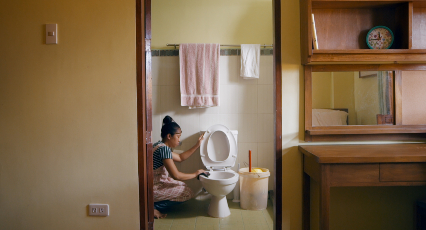 Given the weight of separation (geographical and otherwise) that is woven through her two major films, it is no surprise that physical space plays a crucial role in Overseas. Yoon's meticulous and artfully constructed mise-en-scenes are highlighted through long shots that consistently emphasize the training center setting, such that the surroundings almost become a character in and of themselves—or at the very least, as crucial to understanding the women as their actions. The opening shot features one of the women cleaning a bathroom, enclosed by a doorframe and sharp geometrical lines that add to the austerity and solitude of the scene. With no dialogue, music, or explanatory text, each second feels agonizingly long as we start to experience the monotony of the woman's labor and share the sharp loneliness of being in a house that she cannot claim her own home. Never looking directly at the camera, always at a distance, the woman is unable to hold back her choked sobs even as she continues cleaning. Yoon's camera thus functions as its own kind of distance, manipulating our gaze in a self-reflexive manner and awakening us to how we—those of us in the Western world, safely ensconced in our own privilege—are taught to see these women as invisible, their identities tethered to the spaces they inhabit.
Given the weight of separation (geographical and otherwise) that is woven through her two major films, it is no surprise that physical space plays a crucial role in Overseas. Yoon's meticulous and artfully constructed mise-en-scenes are highlighted through long shots that consistently emphasize the training center setting, such that the surroundings almost become a character in and of themselves—or at the very least, as crucial to understanding the women as their actions. The opening shot features one of the women cleaning a bathroom, enclosed by a doorframe and sharp geometrical lines that add to the austerity and solitude of the scene. With no dialogue, music, or explanatory text, each second feels agonizingly long as we start to experience the monotony of the woman's labor and share the sharp loneliness of being in a house that she cannot claim her own home. Never looking directly at the camera, always at a distance, the woman is unable to hold back her choked sobs even as she continues cleaning. Yoon's camera thus functions as its own kind of distance, manipulating our gaze in a self-reflexive manner and awakening us to how we—those of us in the Western world, safely ensconced in our own privilege—are taught to see these women as invisible, their identities tethered to the spaces they inhabit.
Sequestered in this training center (according to an interview with the director, the women's phones are confiscated and they must spend the night at the center for the duration of the training), we see the women in an array of disciplinary spaces—the classroom, hospital, and (other people's) homes—where they must rehearse a number of rules and behaviors that rigidly set the parameters of acceptable behavior. In following these women across these spaces, the process of care's systematization into a series of easily reproducible steps is laid bare, along with the way these women are slowly folded into this structure.
The setting of the center deserves particular attention, not only because the women are secluded there for a prolonged period of time, but because of its uncanny resemblance to a film set. With rooms that mimic the homes of their future employers, the women also conduct training exercises in which they roleplay being both the employer and the worker— sometimes, the scenes of flagrant abuse to help inoculate them against the worst of what their future jobs may bring. In one striking scene, the women rehearse a scenario where the employer's husband attempts to rape them. As one of the women pretending to be the man threatens "you need the money, right?" the other woman struggles to get away, only managing to do so by spraying perfume in his (her) eyes. This viscerally brutal scene, even if only make-believe, immediately cuts away to the classroom, with the teacher asking the women if using the perfume was the right move and if there were other ways they could have defended themselves. Despite their discussion of various ways to protect themselves, the teacher ultimately concludes with: "If worse comes to worst, go to your agencyˇ¦ Your agency will find ways to arrest the employer or talk to them. But as a last resort, go to Immigration. But do not kill. Do not get a knife. Because you have a contract, and you have a family." Even as these violent simulations are met with reassurances by the center employees that "You are human beings. You are not animals. They cannot trample on your rights," the very need for these kinds of exercises underscores the precarious lives of these women and the flimsy safety offered them by legal rights and institutions. In other words, the onus of responsibility is placed entirely upon the women and it is only too clear what little protection they truly have.
Of course, this is not to say that these women are somehow naïve and helpless. In the rare moments away from the center's watchful gaze, they share among themselves useful advice, their burdens, their hopes and dreams. In these scenes of camaraderie, the shots themselves become more intimate, depicting them in smaller spaces and using close-ups. In one such moment, the women freely scoff at President Duterte's claims that the "OFWs are heroes," stating "How can you be a hero when you just work for your own family's future?" and insightfully discern that they are praised by the government as "heroes of the economy" only because they inject foreign capital into the Philippines' economy— empty words that bring no material benefit to their lives. To assume that these women are somehow simple, helpless individuals that have fallen for the propagandist assertions that the work they are doing is somehow noble or patriotic, would be a grave mistake— they appraise with clarity the true nature of their work, yet have decided to do it out of their free will. The film thereby counters any smug notions of Western superiority that want to paint these women as either helpless victims or the uneducated and uninformed who would jump at the chance to work in wealthier countries.
 And yet it is this collision between individual agency and encompassing structures that gives rise to the film's central paradox. What Overseas presents us with is the illusion of choice and freedom in a fundamentally unequal world— of the contradictory ways our current society professes to value freedom and autonomy, but actually creates the institutions for the purpose of absolving ourselves of any responsibilities to take care of the people we are charged with protecting. In one of the last scenes, the women are at the immigration office (one of the institutions that the center claimed would help them in times of trouble), with scores of people waiting in a cramped room to have their numbers called. The camera shifts to the back offices, using a languorous long take to guide us from the office, to the hallways, and to the ever-expanding piles of papers that represent the futures of the people waiting outside. In this world of supposed freedom, people are reduced to sheets of paper in bureaucratic processes, perpetually waiting for some kind of governmental approval or disapproval. Freedom, then, is only the ability to choose between a set of increasingly diminishing options circumscribed by omnipresent institutions.
And yet it is this collision between individual agency and encompassing structures that gives rise to the film's central paradox. What Overseas presents us with is the illusion of choice and freedom in a fundamentally unequal world— of the contradictory ways our current society professes to value freedom and autonomy, but actually creates the institutions for the purpose of absolving ourselves of any responsibilities to take care of the people we are charged with protecting. In one of the last scenes, the women are at the immigration office (one of the institutions that the center claimed would help them in times of trouble), with scores of people waiting in a cramped room to have their numbers called. The camera shifts to the back offices, using a languorous long take to guide us from the office, to the hallways, and to the ever-expanding piles of papers that represent the futures of the people waiting outside. In this world of supposed freedom, people are reduced to sheets of paper in bureaucratic processes, perpetually waiting for some kind of governmental approval or disapproval. Freedom, then, is only the ability to choose between a set of increasingly diminishing options circumscribed by omnipresent institutions.
Who, then, cares for the caregivers? The explicitly gendered nature of caregiving work as well as the fact that the women are forced to use English in their jobs— it is all too obvious who we deem worthy of receiving care, of caring about, in this world. Throughout the film, I had desperately craved some private, intimate moment with the women— away from the center's watchful gaze, to grant them some kind of reprieve from the constant surveillance they were under. We are finally granted such a moment in the film's last scene, which features poetic behind-the-shoulder shots of one of the women walking through fields and gazing at the mountains, another woman embracing her sleeping child in bed before getting up to leave, and the elegiac ending where the women silently sit in a boat floating across the water in the dead of night. Strikingly, this is one of the few scenes that are marked by extreme close-ups of the women's faces, shadowed in darkness as the haunting refrains of a song plead: Is there still someone waiting for people like me? Is there still hope for happiness in this world? Though I found myself profoundly uncomfortable with this injection of melodramatic sentimentality to convey the women's pain as they drifted away into the unknown, I was simultaneously forced to question what exactly caused my feelings of discomfort. In the end, it seems to have been the lack of any language, visual or spoken, melodramatic or documentary, in the film that is capable of adequately capturing the litany of losses faced by these women: one that does not solely depict them as victims, nor excuse the myriad institutions and organizations that create and render invisible their suffering. Overseas acts as a prescient reminder that in our current world, our own comfort comes at the cost of someone else's labor and loss, forcing us to interrogate the unequal ways we are all entangled with one another, in the hopes of someday finding precisely this language. (Rachel Min Park)
In his novel, Giovanni's Room, James Baldwin writes: "People can't, unhappily, invent their mooring posts, their lovers and their friends, any more than they can invent their parents. Life gives these and also takes them away and the great difficulty is to say Yes to life." There is a scene in Minari where Monica (brilliantly played by Han Ye-ri) cries upon receiving chili powder and dried anchovies from her mother, who has just arrived from South Korea— a brief but striking reminder of the figurative and literal longing for a taste of home. It is a sentiment all too familiar among immigrants or their children, for any of us who find ourselves unanchored and drifting away from home. Director Lee Isaac Chung's latest feature film, Minari, is replete with such moments of resonance for the Korean-American diaspora, with the desperate desire to cling onto whatever mooring posts one can find in a strange and unfamiliar land. Following the story of the Korean-American Yi family, Minari is a quiet, yet tightly-woven film that sharply evokes the emotional textures of family and loss through the luminous cinematography of Lachlan Milne (Hunt for the Wilderpeople, Family Happiness) and the soaring score of Emile Mosseri (The Last Black Man in San Francisco). Its power is located precisely in how familiar, yet simultaneously unique its story is, using a universal lexicon of sacrifice, family, and resilience to articulate a specific tale of Korean-American immigration.
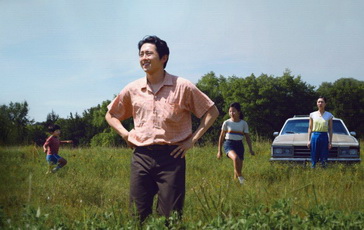 Comprised of Jacob (Steven Yeun), Monica, and their two children, Anne (Noel Kate Cho) and David (Alan Kim), the Yis move from California to Arkansas to pursue Jacob's dream of starting his own farm that grows Korean fruits and vegetables. For Jacob, this move is a thrilling adventure that promises a better future for him and his family. Monica, however, is more doubtful, anxious over their ever-dwindling savings and coping with the sheer loneliness of their lives in this tiny Arkansas town. Immediately, a tension develops between romanticism and pragmatism that falls along gendered lines. As Jacob pursues his dream, it is Monica who must bear the brunt of taking care of the family, ensuring that the children are cared for, the bills paid, and food put on the table. Their situation is further complicated by their son David's congenital heart murmur, which requires special care and monitoring. In the end, Jacob concedes to bringing Monica's mother over from South Korea, to help around the house and alleviate his wife's own loneliness in this mostly-white town.
Comprised of Jacob (Steven Yeun), Monica, and their two children, Anne (Noel Kate Cho) and David (Alan Kim), the Yis move from California to Arkansas to pursue Jacob's dream of starting his own farm that grows Korean fruits and vegetables. For Jacob, this move is a thrilling adventure that promises a better future for him and his family. Monica, however, is more doubtful, anxious over their ever-dwindling savings and coping with the sheer loneliness of their lives in this tiny Arkansas town. Immediately, a tension develops between romanticism and pragmatism that falls along gendered lines. As Jacob pursues his dream, it is Monica who must bear the brunt of taking care of the family, ensuring that the children are cared for, the bills paid, and food put on the table. Their situation is further complicated by their son David's congenital heart murmur, which requires special care and monitoring. In the end, Jacob concedes to bringing Monica's mother over from South Korea, to help around the house and alleviate his wife's own loneliness in this mostly-white town.
Grandmother Soon-ja (played by the incomparable veteran actor Youn Yuh-jung) injects the film with an exuberant liveliness. Loud, bawdy, and joyfully free in a way that Monica and Jacob never are, Grandma provokes complicated feelings in David, who says she "smells like Korea" and dislikes that she is not like other (American) grandmothers. Like other precocious children, David is able to sense the differences that mark him and his family from other Americans (even if he may not be able to fully comprehend them) and his grandmother becomes the most tangible reminder of whatever "Korean-ness" might be. And for better or worse, she is also a reminder that he belongs to this genealogy of difference as the lines between "American" and "Korean" increasingly calcify, with subtle comments fortifying this division thrown throughout the film such as "Grow them the Arkansas way," "Korean people use their heads," "Korean vegetables and Korean fruits," and "They come to America and forget everything."
While the film mostly focuses on the intricate family dynamics as they undergo hardship after hardship, Minari also weaves in moments of joy— lushly shot sequences glazed with the lingering residue of memory that emphasize the beautiful natural landscape. These scenes stand in stark contrast to the dark and cold factory where Monica and Jacob work separating the male chicks from the female ones, the former destined to be killed as the cost of caring for them outweighs the profit they will produce. Despite the visible contrast between the farmland and the factory, the two spaces become entangled and press us to ponder the consequences of pursuing material success, following the siren song of the so-called "American Dream" that promises prosperity to anyone as long as they work hard.
Yet this "pull yourself up by the bootstraps" mentality is undermined by the array of bodies breaking within the film—bodies that are unable, or refuse, to bend to the requirements of work. David's heart murmur is the most notable example, but there are also more subtle ones, such as Jacob's sore and immobile arms after constant farm labor and Grandma's partial paralysis after her stroke. In one scene, David pulls out a dresser drawer and it falls on his leg. Through cross-cutting, it is seamlessly blended with Jacob dropping a tray of chicks at the factory, his tired arms unable to properly carry the tray. As Monica and Jacob frantically attempt to scoop the chicks back up, a co-worker tells them not to bother, casually mentioning "If they're injured, we throw them away," and the camera cuts away again to David's injured leg. With this cinematic slippage, we see the parallels drawn between father and son across space and time, but also the triangulation between bodies, physical labor, and injury.
This question of disposability, of throwing away that which is not useful (with usefulness here presumably defined by whether or not it will produce profit) complicates the notions of success and happiness it supposedly brings. As the film progresses, Jacob's obsession with the farm intensifies as it becomes the sole recipient of his time and energy. He consistently claims that he is doing this for his family, that all his hard work and suffering is for a greater cause. But his actions say otherwise: he chooses to pay for enough water to sustain the crops instead of the water bill at home for his family; he comes in late to his son's medical appointment and brings his box of precious produce to the doctor's office to keep it from spoiling in the car. Yet at the same time, it is difficult to blame or hate Jacob— perhaps because it is all too easy for us to recognize how good intentions degrade into toxic obsessions, or perhaps because his pain feels all too familiar. As Jacob desperately claws at the fragments of his dreams, it is his family that is deemed "disposable" in the calculus of success posited by the American dream. The film thus gently reminds us of what (or who) we throw away when we adhere to the mandates of productivity and utility, that there is always a cost to our actions.
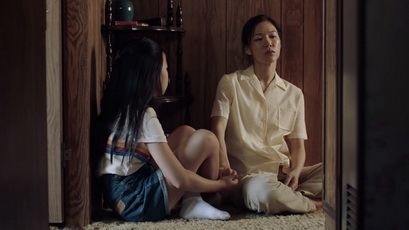 Minari should be applauded for illuminating the life of the Korean diaspora in the rural US, especially considering that major urban centers such as Los Angeles and New York tend to dominate Asian American narratives. As a Korean-American myself, I was undeniably moved by the film, and it is difficult to resist the allure of identifying with its broader themes of loss, pain, and belonging in the diasporic context. But I also found myself exhausted from the film's relentless portrayal of resilience needed to merely survive in this cruel country, the demands placed on women to be caregivers, along with the moralizing manner in which surviving hardships is depicted as somehow making a person stronger for having suffered them. That the film ultimately concludes on a scene with David and Jacob, between father and son, further saddened me as I grieved for the eldest daughters, mothers, and grandmothers of immigrant families whose sacrifices are so often taken for granted.
Minari should be applauded for illuminating the life of the Korean diaspora in the rural US, especially considering that major urban centers such as Los Angeles and New York tend to dominate Asian American narratives. As a Korean-American myself, I was undeniably moved by the film, and it is difficult to resist the allure of identifying with its broader themes of loss, pain, and belonging in the diasporic context. But I also found myself exhausted from the film's relentless portrayal of resilience needed to merely survive in this cruel country, the demands placed on women to be caregivers, along with the moralizing manner in which surviving hardships is depicted as somehow making a person stronger for having suffered them. That the film ultimately concludes on a scene with David and Jacob, between father and son, further saddened me as I grieved for the eldest daughters, mothers, and grandmothers of immigrant families whose sacrifices are so often taken for granted.
That Minari's themes and images will inevitably resonate with so many in the diaspora is somewhat of a bittersweet point. Certainly there is the quick balm granted by representation, the temporary alleviation of loneliness and alienation provided by seeing your own experiences reflected on-screen and realizing you are not so alone. But there is a deeper sadness in recognizing that so many people experienced the same trauma, the same heartaches and loss. In the end, despite the affective resonance provided by representation, what I long for is that nobody, no family should ever go through this— that trauma and pain should not be the cornerstone of a shared collective experience.
Time and time again, my thoughts return to one scene, where David tries and fails to run because of his weak heart. Grandma reassures him and tells him it's okay to walk, proposing "Let's go slowly. Slowly." More than the eponymous minari plant that thrives on its own, after surviving its transplantation into foreign soil, it is this slowness with which I hope we shape our lives. For all those broken in the world to resist the breakneck speed demanded by modern society. For us to walk together, slowly, in saying Yes to life. (Rachel Min Park)
There is a scene in Adachi Mojiri's Japanese film The Harbor Lights that reminded me of a scene from Iranian director Jafar Panahi's The Circle (2000). Both scenes happen behind a closed door. Both scenes don't allow us to see behind the door. We only hear what is happening behind it. Both scenes are harrowing, but in different ways. In Panahi's film, it is an act of domestic violence that is occluded. In Adachi's film it is a young woman's wailing from the emotional pain of depression. Both scenes stay with the door for a fair amount of time so the audience must hold the discomfort of what they are hearing. We are forced to imagine for ourselves what is happening visually behind the door. Our creation of the visuals in our head imbeds the moment more firmly in our minds and in our hearts.
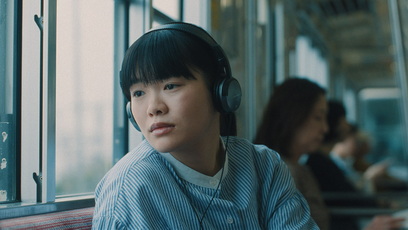 The Harbor Lights is a film about a Zainichi family in Kobe, Japan. Akari (Tomita Miu, Let's Go Jets and the Japanese remake of the original Korean film Sunny) is our main focus, the middle child of a family of recently divorced parents. Akari's relationship with her father is full of emotional pain. Her father is full of emotional pain. This pain is epigenetic, passed on from family, but more so imposed on the family via the history of Japanese colonialism. The grandmother's trials as Zainichi, a Korean under colonization moving to Japan to raise her family in a country that bureaucratically and politically designates her, and her family, as lesser, forced upon her a life of hardship after hardship after hardship.
The Harbor Lights is a film about a Zainichi family in Kobe, Japan. Akari (Tomita Miu, Let's Go Jets and the Japanese remake of the original Korean film Sunny) is our main focus, the middle child of a family of recently divorced parents. Akari's relationship with her father is full of emotional pain. Her father is full of emotional pain. This pain is epigenetic, passed on from family, but more so imposed on the family via the history of Japanese colonialism. The grandmother's trials as Zainichi, a Korean under colonization moving to Japan to raise her family in a country that bureaucratically and politically designates her, and her family, as lesser, forced upon her a life of hardship after hardship after hardship.
During the Q&A of the film's debut at the 2024 Tokyo International Film Festival, I wanted to ask about the behind closed door scene, but another audience member asked before I could. Adachi revealed that the decision to occlude the moment was not planned. They had filmed both in front of and behind the door and made a decision to keep the visual obstruction in place. During this scene, the audio does sound a bit off. It isn't as muffled as one would expect, but appears to be the audio caught from behind the door even though we, the audience, are looking from the room outside the door. I don't consider this to be a "mistake," but instead an interesting choice since it gets us to focus on the sound even more. It takes us inside through a sense many in the audience might not focus on. As a result, we feel the scene differently. As a result, we absorb the scene differently.
Akari learns two things from her therapy that she engages in after during a sustained episode of depression. She learned meditation techniques to focus on her breath. The repetition of this mantra encourages the audience to focus on their breath as well. The behind closed door scene is a space where I was watching my breath, holding the aural witnessing of the difficult moment. Since moving to Japan for my own family reasons, I have been out of my cinematic practice since so many films are unavailable to me in my preferred method of screening, the cinema. (I do not know Korean and cannot read Japanese at the speed subtitles demand.) I watch films on my TV but this medium often has me distracted, daydreaming about future plans for the week or various stressors in my life. And because my finances are not what they once were, I go to the cinema less. This means I am out of practice in the cinema. While watching The Harbor Lights, I found myself drifting in the comfortable seats of the Hibiya Toho Cinema. But the reminders about breathing throughout the film helped me to return to the actions and sounds of the screen. Breathing helped me hold the history that affects the futures of these characters.
The other mantra repeated in Akari's notebook is about not expecting 100% understanding from others. Her therapist recognizes her pain as partially from not being understood, from failed connection with those who matter to her. Akari's struggles with her father center on his refusal to understand his daughter. By letting go of the need for complete understanding, Akari is able to develop other tactics when interacting with her father.
We can also flip this 100% non-expectation the other way—Akari doesn't have to 100% understand her father either. Yet much of the film is her attempt to understand him by returning to her father's home town of Nagata Ward in Kobe where she learns of her father's immigrant history and connects it to the current immigrant history of Vietnamese and a recent Ukrainian refugee family. Akari's efforts to connect these immigrant experiences is the opposite of the hate-fueled efforts of my home country perpetrated by the likes of recent Vice President Elect JD Vance. Rather than connect his Appalachian-ness struggles to that of Haitian immigrants, Vance, who comes from my home state of Ohio, has spread vicious racist, xenophobic lies about the Haitian immigrant community in Springfield, Ohio, in order to scapegoat them to further benefit his whiteness. Akari is the anti-Vance, seeing the connections in her own Zainichi Elegy and making an effort to advocate for, not antagonize, new immigrant communities. With this emotional template, she continues to try and build a connection with her father. It is in this way that The Harbor Lights is a lighthouse guiding me towards hope that I so desperately need as autocracy surges forward to take hold in my own home country at the expense of immigrants, minorities, women and queer folk. I am doing my own emotional wailing behind closed doors, but I will come out to create as much light as I can while there is still time. (Adam Hartzell)